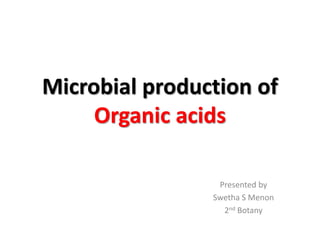
Microbial Production Organic Acids Citric Lactic
- 1. Microbial production of Organic acids Presented by Swetha S Menon 2nd Botany
- 2. INTRODUCTION • A large number of organic acids with actual or potential uses are produced by microorganisms. Citric, itaconic, lactic, malic, tartaric, gluconic, mevalonic, salicylic, gibberellic, diaminopimelic, and propionic acids are some of the acids whose microbial production have been patented.
- 3. i. Citric Acid • Citric acid is a tribasic acid citric acid structure
- 4. • It crystallizes with the large rhombic crystals containing one molecule of water of crystallization, which is lost when it is heated to 130°C. At temperatures as high as 175°C it is converted to itaconic acid, aconitic acid, and other compounds.
- 5. Uses of Citric Acid • (i) Citric acid is the major food acidulant used in the manufacture of jellies, jams, sweets, and soft drinks. • (ii) It is used for artificial flavoring in various foods including soft drinks. • (iii) Sodium citrate is employed in processed cheese manufacture
- 6. Biochemical Basis of the Production of Citric Acid • Citric acid is an intermediate in the citric acid cycle (TCA). The acid can therefore be caused to accumulate by one of the following methods; • By mutation • By inhibiting the free-flow of the cycle through altering the environmental conditions
- 7. Fermentation for Citric Acid Production • Fermentation is the most economical and widely used ay for synthesis citric acid production. • The industrial citric acid production can be carried in three different ways: surface fermentation submerged fermentation
- 8. (a) Surface fermentation • Surface fermentation using Aspergillus niger may be done on rice bran as is the case in Japan, or in liquid solution in flat aluminium or stainless steel pans. • Special strains of Aspergillus niger which can produce citric acid despite the high content of trace metals in rice bran are used.
- 9. SUBMERGED FERMENTATION • In this case , the strains are inoculated of about 15cm depth in fermentation tank. • The culture is enhanced by giving aeration using air bubbles. • And its allowed to grow for about 5 to 14 days at 27 to 33 degree Celsius. • The citric acid produced in the fermentation tank and it is purified.
- 10. Separation • The biomass is separated by filtration. • The liquid is transferred to recovery process • Separation of citric acid from the liquid precipitation. • Calcium hydroxide is added to obtain calcium citrate.
- 11. • Tetra hydrate Wash the precipitate Dissolve it with dilute sulfuric acid, yield citric acid and calcium sulfate precipitate Bleach and crystallization Anhydrous or mono hydrate citric acid Separation process
- 12. PURIFICATION • Purification is a simple form of getting a pure citric acid followed by two simple techniques Precipitation &Filtration React citric acid with calcium carbonate Filter precipitate Filter precipitate React precipitate with sulfuric acid Purified citric Acid
- 13. Lactic Acid • Lactic acid is produced by many organisms: animals including man produce the acid in muscle during work.
- 14. Uses of lactic acid • It is used in the baking industry. Originally fermentation lactic acid was produced to replace tartarates in baking powder with calcium lactate. Later it was used to produce calcium stearyl-2lactylate, a bread additive. • In medicine it is sometimes used to introduce calcium in to the body in the form of calcium lactate, in diseases of calcium deficiency.
- 15. • Esters of lactic acid are also used in the food industry as emulsifiers. • Lactic acid is used in the manufacture of rye bread. • It is used in the manufacture of plastics.
- 16. Fermentation for lactic acid • Although many organisms can produce lactic acid, the amounts produced are small; the organisms which produce adequate amounts and are therefore used in industry are the homofermentative lactic acid bacteria, Lactobacillus spp., especially L. delbrueckii. • In recent times, Rhizopus oryzae has been used.
- 17. • Both organisms produce the L-form of the acid, but , • Rhizopus fermentation has the advantage of being much shorter in duration; furthermore, the isolation of the acid is much easier when the fungus is used. • Although lactic fermentation is anaerobic, the organisms involved are facultative and while air is excluded as much as possible, complete anaerobiosis is not necessary. The temperature of the fermentation is high in comparison with other fermentations and is around 45°C. Contamination is therefore not a problem, except by thermophilic clostridia.
- 18. Extraction • The fermentation broth is filtered by using porcelain filters to separate the bacterium. • The filtrate is acidified with sulphuric acid to regenerate lactic acid, to precipitate calcium as calcium sulphate and is washed. • .The washed filtrate is treated with activated carbon to remove organic impurities.
- 19. • Repeated refining and evaporation steps are undertaken to get higher percentage of lactic acid to the extent of 50-60%. • It is then treated with ferrocyanide to remove heavy metals, if any, like copper. • It is finally purified by passing through ion exchange resins.
- 20. MANY OF ORGANIC ACIDS ARE FOUND IN LIVING THINGS
